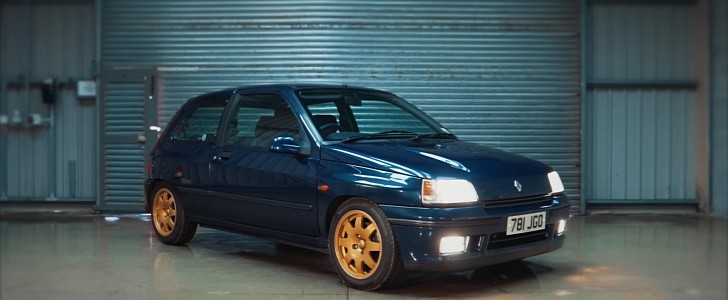We all know Collin McCrae made blue popular on sports cars. But before that, there was the Renault Clio Williams Homologation Special - a slice of gold-wheeled goodness. If memory serves us right, this was the first hot hatch to put the legendary Peugeot 205 GTi in its place.
Ending the reign of the mighty 205 GTI wasn’t an easy task, but it wasn’t impossible. You’ll have to agree with me here, the 205 GTi isn’t really a hard car to beat by today’s standards, and much of its power lies in the minds of its followers.
It might be easy to assume the Renault Clio Williams was a tribute to Nigel Mansell and Williams Renault F1 team for their championship titles in 1992. However, the 1993 Renault Clio Williams is actually a homologation car.
The hot hatch was first produced in 1993 and cost £13,275 brand new, the U.K only getting 390 of the phase one cars. Renault wanted to take the Clio for rally racing, forcing the company to develop an homologation special for the public.
Fortunately, in 1993, the Renault-Williams team won the F1 World Championship title, and it all came together in the Renault Clio Williams. Renault planned to sell 3,800 homologation specials but ended up selling 5,400. It was so successful they did a Williams II and III - which did not flatter the first-gen owners. In total, Renault produced 12,100 units of these fantastic cars.
Instead of the feeble 16-valve 1.8-liter engine, the Renault Clio Williams got a 2.0-liter four-cylinder engine making 145 hp and 169 Nm of torque at 2,500 rpm. The new engine wasn’t just bigger but had a stronger crankshaft, new camshaft, revised gear ratios, new pistons, bigger valves, and a less weighty exhaust manifold.
Weighing around 980 kg, driving this hot hatch gives you that feeling of a big engine inside a small car. The result? It's a nostalgic, fun, throttle-happy, 90s, track car.
It might be easy to assume the Renault Clio Williams was a tribute to Nigel Mansell and Williams Renault F1 team for their championship titles in 1992. However, the 1993 Renault Clio Williams is actually a homologation car.
The hot hatch was first produced in 1993 and cost £13,275 brand new, the U.K only getting 390 of the phase one cars. Renault wanted to take the Clio for rally racing, forcing the company to develop an homologation special for the public.
Fortunately, in 1993, the Renault-Williams team won the F1 World Championship title, and it all came together in the Renault Clio Williams. Renault planned to sell 3,800 homologation specials but ended up selling 5,400. It was so successful they did a Williams II and III - which did not flatter the first-gen owners. In total, Renault produced 12,100 units of these fantastic cars.
Instead of the feeble 16-valve 1.8-liter engine, the Renault Clio Williams got a 2.0-liter four-cylinder engine making 145 hp and 169 Nm of torque at 2,500 rpm. The new engine wasn’t just bigger but had a stronger crankshaft, new camshaft, revised gear ratios, new pistons, bigger valves, and a less weighty exhaust manifold.
Weighing around 980 kg, driving this hot hatch gives you that feeling of a big engine inside a small car. The result? It's a nostalgic, fun, throttle-happy, 90s, track car.










